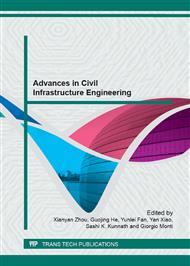p.470
p.474
p.481
p.485
p.489
p.493
p.498
p.502
p.510
Analysis of Interference Effects of Adjacent Buildings on Wind Pressures
Abstract:
This paper presents numerical and experimental investigations of wind-induced interference effects on the pressure distributions on an adjacent building. The relative locations of the interfered building model and the interfering model are sited in staggered arrangement. The wind tunnel tests were carried out in a low-speed boundary layer wind tunnel. The numerical predictions for pressure distribution on the principal building are performed by solving the Reynolds-averaged Navier–Stokes (RANS) equations using the renormalization group (RNG) k–e turbulence model and then compared with the measurements. The RANS equations are solved by the pressure correction procedure of the SIMPLEC method. The simulated pressure, base force and base moment coefficients in different wind directions are generally in good agreement with the corresponding wind tunnel data. It is also found that the wind pressures, base forces and moments on the testing building are affected to some extent by the interference from adjacent buildings. The numerical simulation applying the SIMPLEC method using the QUICK upwind scheme and the RNG k–e turbulence model seems to be a useful tool for the predictions of wind pressures, and especially the wind forces acting on a building with an adjacent building.
Info:
Periodical:
Pages:
489-492
Citation:
Online since:
January 2013
Authors:
Price:
Сopyright:
© 2013 Trans Tech Publications Ltd. All Rights Reserved
Share:
Citation:


